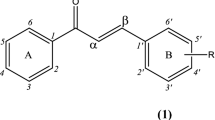Abstract
Six eugenol glycosides were prepared in order to assess their antifungal activity against Candida species. They were synthesized by glycosylation of eugenol with the appropriate glycosyl bromides followed by deacetylation with sodium methoxide in methanol and were evaluated in vitro for their antifungal activity through a Mueller–Hinton broth microdilution method. The peracetyl glycoside (derivative 4) was the most promising one since it was able to inhibit growth of C. albicans, C. tropicalis and C. glabrata with IC50 values much lower than that of the prototype eugenol. Derivative 4 showed to be 160.0 and 3.4 times more potent than eugenol and fluconazole, respectively, against C. glabrata with low cytotoxity (selectivity index of 45). Moreover, it was possible to verify the positive effect of gluco configuration and lipophilicity on antifungal activity, since glucose peracetyl derivatives were more active than the free sugars of galacto configuration.

Similar content being viewed by others
References
Ahmad A, Khan A, Yousuf S, Khan LA, Manzoor N (2010) Proton translocating ATPase mediated fungicidal activity of eugenol and thymol. Fitoterapia 81:1157–1162
Atsumi T, Fujisawa S, Satoh K, Sakagami H, Iwakura I, Ueha T, Sugita Y, Yokoe I (2000) Cytotoxicity and radical intensity of eugenol, isoeugenol or related dimers. Anticancer Res 20:2519–2524
Babich H, Stern A, Borenfreund E (1993) Eugenol cytotoxicity evaluated with continuous cell lines. Toxicol In Vitro 7:105–109
Bush K, Pucci MJ (2011) New antimicrobial agents on the horizon. Biochem Pharmacol 82:1528–1539
Carrasco H, Raimondi M, Svetaz L, Di Liberto M, Rodriguez MV, Espinoza L, Madrid A, Zacchino S (2012) Antifungal activity of eugenol analogues: influence of different substituents and studies on mechanism of action. Molecules 17:1002–1024
Clinical and Laboratory Standards Institute (CLSI) (2008) Reference method for broth dilution antifungal susceptibility testing of yeasts. Approved Standard-Third Edition. M27-A3. CLSI, Wayne, PA, USA
Daniel AN, Sartoretto SM, Schmidt G, Caparroz-Assef SM, Bersani-Amado CA, Cuman RKN (2009) Anti-inflammatory and antinociceptive activities of eugenol essential oil in experimental animal models. Braz J Pharmacog 19(1B):212–217
Devi KP, Nisha SA, Sakthivel R, Pandian SK (2010) Eugenol (an essential oil of clove) acts as an antibacterial agent against Salmonella typhi by disrupting the cellular membrane. J Ethnopharmacol 130:107–115
Dias KS, Januário JP, D’ Dego JL, Dias AL, dos Santos MH, Camps I, Coelho LF, Viegas C Jr (2012) Semisynthesis and antimicrobial activity of novel guttiferone-A derivatives. Bioorg Med Chem 20(8):2713–2720
Guenette SA, Beaudry F, Marier JF, Vachon P (2006) Pharmacokinetics and anesthetic activity of eugenol in male Sprague–Dawley rats. J Vet Pharmacol Therap 29:265–270
Hidalgo ME, De la Rosa C, Carrasco H, Cardona W, Gallardo C, Espinoza L (2009) Antioxidant capacity of eugenol derivatives. Quim Nova 32(6):1467–1470
Jacobson M, Malmberg J, Ellervik U (2006) Aromatic O-glycosylation. Carbohydr Res 341:1266–1281
Jung M, Park M (2007) Acetylcholinesterase inhibition by flavonoids from Agrimonia pilosa. Molecules 12:2130–2139
Kabuto H, Tada M, Kohno M (2007) Eugenol [2-methoxy-4-(2-propenyl)phenol] prevents 6-hydroxydopamine-induced dopamine depression and lipid peroxidation inductivity in mouse striatum. Biol Pharm Bul 30:423–427
Lahloua S, Figueiredo AF, Magalhães PJC, Leal-Cardoso JH, Gloria PD (2004) Cardiovascular effects of methyleugenol, a natural constituent of many plant essential oils, in normotensive rats. Life Sci 74:2401–2412
Li L, Redding S, Dongari-Bagtzoglou A (2007) Candida glabrata: an emerging oral opportunistic pathogen. J Dent Res 86:204–215
Machado M, Dinis AM, Salgueiro L, Custódio JBA, Cavaleiro C, Sousa MC (2011) Anti-Giardia activity of Syzygium aromaticum essential oil and eugenol: effects on growth, viability, adherence and ultrastructure. Exp Parasitol 127:732–739
Manikandan P, Senthil RM, Priyadarsini RV, Vinothini G, Nagini S (2010) Eugenol induces apoptosis and inhibits invasion and angiogenesis in a rat model of gastric carcinogenesis induced by MNNG. Life Sci 86:936–941
Mitchell SA, Pratt MR, Hruby VJ, Polt R (2001) Solid-phase synthesis of O-linked glycopeptide analogues of enkephalin. J Org Chem 66:2327–2342
Moellering RC Jr (2011) Discovering new antimicrobial agents. Int J Antimicrob Agents 37:2–9
Mulkens A, Kapetanidis I (1988) Eugenylglucoside, a new natural phenylpropanoid heteroside from Melissa officinalls. J Nat Prod 51(3):496–498
Oyedemi SO, Okoh AI, Mabinya LV, Pirochenva G, Afolayan AJ (2009) The proposed mechanism of bactericidal action of eugenol, α-terpineol and γ-terpinene against Listeria monocytogenes, Streptococcus pyogenes, Proteus vulgaris and Escherichia coli. Afr J Biotechnol 8(7):1280–1286
Pasqualotto AC, Denning WD (2008) New and emerging treatments for fungal infections. J Antimicrob Chemother 61(1):i19–i30
Pramod K, Ansari SH, Ali J (2010) Eugenol: a natural compound with versatile pharmacological actions. Nat Prod Commun 5(12):1999–2006
Prashar A, Locke IC, Evans CS (2006) Cytotoxicity of clove (Syzygium aromaticum) oil and its major components to human skin cells. Cell Prolif 39:241–248
Roy R, Kim JM (2003) Cu(II)-self-assembling bipyridyl-glycoclusters and dendrimers bearing the Tn-antigen cancer marker: synthesis and lectin binding properties. Tetrahedron 59:3881–3893
Ueda-Nakamura T, Mendonça-Filho RR, Morgado-Diaz JM, Maza PK, Dias Filho BP, Cortez DAG, Alviano DS, Rosa MSS, Lopes AHCS, Alviano CS, Nakamura CV (2006) Antileishmanial activity of eugenol-rich essential oil from Ocimum gratissimum. Parasitol Int 55:10–99
Vandeputte P, Ferrari S, Coste AT (2012) Antifungal resistance and new strategies to control fungal infections. Int J Microbiol 1–26
Zhang P, Zhang E, Xiao M, Chen C, Xu W (2012) Enhanced chemical and biological activities of a newly biosynthesized eugenol glycoconjugate, eugenol α-d-glucopyranoside. Appl Microbiol Biotechnol. doi:10.1007/s00253-012-4351-2
Author information
Authors and Affiliations
Corresponding author
Electronic supplementary material
Below is the link to the electronic supplementary material.
Rights and permissions
About this article
Cite this article
de Souza, T.B., Orlandi, M., Coelho, L.F.L. et al. Synthesis and in vitro evaluation of antifungal and cytotoxic activities of eugenol glycosides. Med Chem Res 23, 496–502 (2014). https://doi.org/10.1007/s00044-013-0669-2
Received:
Accepted:
Published:
Issue Date:
DOI: https://doi.org/10.1007/s00044-013-0669-2



